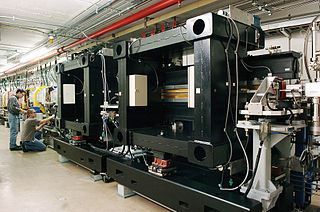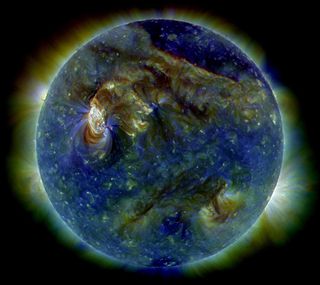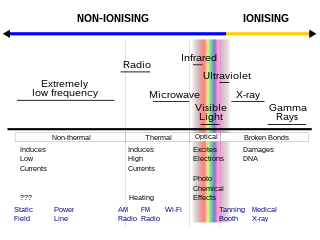Radiation is a process in which a body emits energy that propagates through a medium or through empty space, but is absorbed by other bodies. Radiation may also refer to:
Radiation is a process in which a body emits energy that propagates through a medium or through empty space, but is absorbed by other bodies. Radiation may also refer to:

In physics, electromagnetic radiation (EMR) consists of waves of the electromagnetic (EM) field, which propagate through space and carry momentum and electromagnetic radiant energy. Types of EMR include radio waves, microwaves, infrared, (visible) light, ultraviolet, X-rays, and gamma rays, all of which are part of the electromagnetic spectrum.

An electromagnetic field is a classical field produced by moving electric charges. It is the field described by classical electrodynamics and is the classical counterpart to the quantized electromagnetic field tensor in quantum electrodynamics. The electromagnetic field propagates at the speed of light and interacts with charges and currents. Its quantum counterpart is one of the four fundamental forces of nature.
The electromagnetic spectrum is the range of frequencies of electromagnetic radiation and their respective wavelengths and photon energies.

Light or visible light is electromagnetic radiation that can be perceived by the human eye. Visible light is usually defined as having wavelengths in the range of 400–700 nanometres (nm), corresponding to frequencies of 750–420 terahertz, between the infrared and the ultraviolet.

In physics, radiation is the emission or transmission of energy in the form of waves or particles through space or through a material medium. This includes:

In physics, mathematics, and related fields, a wave is a propagating dynamic disturbance of one or more quantities. Waves can be periodic, in which case those quantities oscillate repeatedly about an equilibrium (resting) value at some frequency. When the entire waveform moves in one direction, it is said to be a traveling wave; by contrast, a pair of superimposed periodic waves traveling in opposite directions makes a standing wave. In a standing wave, the amplitude of vibration has nulls at some positions where the wave amplitude appears smaller or even zero. Waves are often described by a wave equation or a one-way wave equation for single wave propagation in a defined direction.

Radio waves are a type of electromagnetic radiation with the longest wavelengths in the electromagnetic spectrum, typically with frequencies of 300 gigahertz (GHz) and below. At 300 GHz, the corresponding wavelength is 1 mm ; at 30 Hz the corresponding wavelength is 10,000 kilometers. Like all electromagnetic waves, radio waves in a vacuum travel at the speed of light, and in the Earth's atmosphere at a close, but slightly lower speed. Radio waves are generated by charged particles undergoing acceleration, such as time-varying electric currents. Naturally occurring radio waves are emitted by lightning and astronomical objects, and are part of the blackbody radiation emitted by all warm objects.
Cyclotron radiation is electromagnetic radiation emitted by non-relativistic accelerating charged particles deflected by a magnetic field. The Lorentz force on the particles acts perpendicular to both the magnetic field lines and the particles' motion through them, creating an acceleration of charged particles that causes them to emit radiation as a result of the acceleration they undergo as they spiral around the lines of the magnetic field.

Synchrotron radiation is the electromagnetic radiation emitted when relativistic charged particles are subject to an acceleration perpendicular to their velocity. It is produced artificially in some types of particle accelerators, or naturally by fast electrons moving through magnetic fields. The radiation produced in this way has a characteristic polarization and the frequencies generated can range over a large portion of the electromagnetic spectrum.
In electromagnetics, an evanescent field, or evanescent wave, is an oscillating electric and/or magnetic field that does not propagate as an electromagnetic wave but whose energy is spatially concentrated in the vicinity of the source. Even when there is a propagating electromagnetic wave produced, one can still identify as an evanescent field the component of the electric or magnetic field that cannot be attributed to the propagating wave observed at a distance of many wavelengths.

The near field and far field are regions of the electromagnetic (EM) field around an object, such as a transmitting antenna, or the result of radiation scattering off an object. Non-radiative near-field behaviors dominate close to the antenna or scattering object, while electromagnetic radiation far-field behaviors dominate at greater distances.

An insertion device (ID) is a component in modern synchrotron light sources, so called because they are "inserted" into accelerator tracks. They are periodic magnetic structures that stimulate highly brilliant, forward-directed synchrotron radiation emission by forcing a stored charged particle beam to perform wiggles, or undulations, as they pass through the device. This motion is caused by the Lorentz force, and it is from this oscillatory motion that we get the names for the two classes of device, which are known as wigglers and undulators. As well as creating a brighter light, some insertion devices enable tuning of the light so that different frequencies can be generated for different applications.
The following outline is provided as an overview of and topical guide to energy:

Extreme ultraviolet radiation or high-energy ultraviolet radiation is electromagnetic radiation in the part of the electromagnetic spectrum spanning wavelengths shorter that the hydrogen Lyman-alpha line from 121 nm down to the X-Ray band of 10 nm, and therefore having photons with energies from 10.26 eV up to 124.24 eV. EUV is naturally generated by the solar corona and artificially by plasma, high harmonic generation sources and synchrotron light sources. Since UVC extends to 100 nm, there is some overlap in the terms.

Gurgen Ashotovich Askaryan was a prominent Soviet - Armenian physicist, famous for his discovery of the self-focusing of light, pioneering studies of light-matter interactions, and the discovery and investigation of the interaction of high-energy particles with condensed matter.

A gamma ray, also known as gamma radiation (symbol γ or ), is a penetrating form of electromagnetic radiation arising from the radioactive decay of atomic nuclei. It consists of the shortest wavelength electromagnetic waves, typically shorter than those of X-rays. With frequencies above 30 exahertz (3×1019 Hz), it imparts the highest photon energy. Paul Villard, a French chemist and physicist, discovered gamma radiation in 1900 while studying radiation emitted by radium. In 1903, Ernest Rutherford named this radiation gamma rays based on their relatively strong penetration of matter; in 1900 he had already named two less penetrating types of decay radiation (discovered by Henri Becquerel) alpha rays and beta rays in ascending order of penetrating power.

Alpha particles, also called alpha rays or alpha radiation, consist of two protons and two neutrons bound together into a particle identical to a helium-4 nucleus. They are generally produced in the process of alpha decay, but may also be produced in other ways. Alpha particles are named after the first letter in the Greek alphabet, α. The symbol for the alpha particle is α or α2+. Because they are identical to helium nuclei, they are also sometimes written as He2+
or 4
2He2+
indicating a helium ion with a +2 charge. Once the ion gains electrons from its environment, the alpha particle becomes a normal helium atom 4
2He.

Non-ionizingradiation refers to any type of electromagnetic radiation that does not carry enough energy per quantum to ionize atoms or molecules—that is, to completely remove an electron from an atom or molecule. Instead of producing charged ions when passing through matter, non-ionizing electromagnetic radiation has sufficient energy only for excitation. Non-ionizing radiation is not a significant health risk. In contrast, ionizing radiation has a higher frequency and shorter wavelength than non-ionizing radiation, and can be a serious health hazard: exposure to it can cause burns, radiation sickness, many kinds of cancer, and genetic damage. Using ionizing radiation requires elaborate radiological protection measures, which in general are not required with non-ionizing radiation.
This glossary of physics is a list of definitions of terms and concepts relevant to physics, its sub-disciplines, and related fields, including mechanics, materials science, nuclear physics, particle physics, and thermodynamics. For more inclusive glossaries concerning related fields of science and technology, see Glossary of chemistry terms, Glossary of astronomy, Glossary of areas of mathematics, and Glossary of engineering.